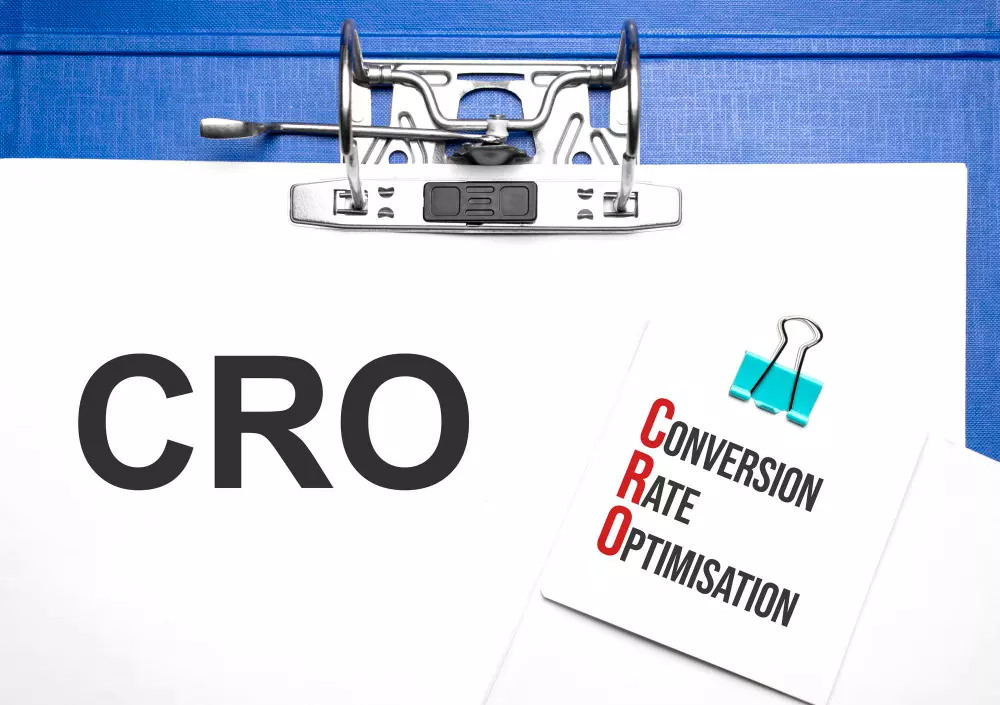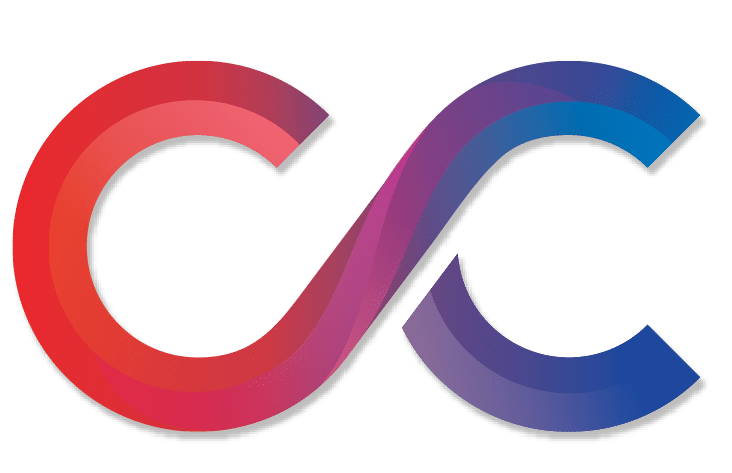What is Conversion Rate Optimization?
Conversion Rate Optimization (CRO) is a systematic and data-driven approach to improving a website’s conversion rate or landing page. The conversion rate refers to the percentage of visitors who complete a desired action, such as purchasing, submitting a form, or signing up for a newsletter.

The process of CRO involves:
- Analyzing user behavior.
- Identifying potential obstacles or barriers to conversion.
- Making strategic changes to optimize the website’s performance.
This optimization aims to improve the overall user experience, reduce friction, and increase the likelihood of visitors taking the desired action.
Types of Conversion Rate Optimization
Businesses can employ various types of conversion rate optimization processes and strategies to improve their conversion rates. Here are some common types of CRO:
- Personalization and Segmentation: Personalization involves tailoring the user experience based on individual preferences, behavior, or demographic information. Businesses can increase relevancy and conversions by segmenting visitors into specific groups and delivering personalized content, recommendations, or offers.
- Mobile Optimization: Optimizing websites for mobile users is the need of the hour with the increasing use of mobile devices. Mobile optimization includes responsive design, mobile-friendly navigation, fast-loading pages, and easy-to-use interfaces to improve the mobile user experience and drive conversions.
- Landing Page Optimization: This type of CRO focuses on optimizing individual landing pages to increase conversions. It involves refining the design, layout, copywriting, and calls-to-action (CTAs) on landing pages to align with user intent and encourage desired actions.
- Form Optimization: Form optimization aims to simplify and streamline online forms, such as sign-up forms, contact forms, or checkout forms. It involves reducing form fields, removing distractions, providing clear instructions, and implementing auto-fill features to make the form submission process as smooth as possible.
- Call-to-Action (CTA) Optimization: Optimizing CTAs involves designing and positioning buttons or links that prompt users to take a specific action. It includes experimenting with different text, colors, sizes, and placements to find the most effective CTAs that drive conversions.
- Pricing and Offer Optimization: This type of CRO tests different pricing strategies, discounts, promotions, and product bundles to find the optimal pricing and offers that entice visitors to convert. It aims to strike a balance between attracting customers and maintaining profitability.
- Checkout Process Optimization: The checkout process is a critical stage where cart abandonment can occur. Optimizing the checkout process involves minimizing friction, simplifying steps, offering guest checkout options, and displaying trust signals to increase the likelihood of completing the purchase.
- Multivariate Testing: Multivariate testing involves simultaneously testing multiple elements on a webpage to identify the most effective combination for increasing conversions. It allows businesses to examine the impact of different varieties of headlines, images, CTAs, and other elements on conversion rates.
- Exit Intent Pop-ups: Exit intent pop-ups are triggered when a visitor is about to leave a website. These pop-ups can present compelling offers, discounts, or lead capture forms to persuade visitors to stay or provide their contact information before leaving.
- Social Proof and Trust Building: Adding social proof elements, such as customer testimonials, reviews, trust badges, security seals, or case studies, can enhance credibility and build trust with visitors, increasing their likelihood of converting.
These are just a few examples of the different types of Conversion Rate Optimization techniques. Selecting and implementing specific CRO strategies depend on each business’s unique needs and goals.
Methodologies used by CRO

There are multiple conversion rate optimization strategies to achieve its goals. These include:
- Data analysis: CRO relies on quantitative data, such as website analytics, to understand user behavior, traffic patterns, and conversion funnel performance. By analyzing this data, businesses can identify areas of improvement and prioritize optimization efforts.
- User research: CRO also involves qualitative research methods, such as user surveys, heatmaps, and user testing, to observe user preferences, motivations, and pain points. This helps understand how users interact with the website and uncover specific areas for improvement.
- A/B testing: An essential aspect of CRO is conducting A/B tests, where different versions of a webpage or specific elements are tested against each other to find which performs better in conversion rate. Businesses can make data-driven decisions and implement changes that positively impact conversions by comparing different variations.
- Conversion funnel optimization: CRO focuses on optimizing the entire conversion funnel, from the initial landing page to the final conversion action. It involves streamlining the user journey, simplifying the checkout process, improving form design, and enhancing the overall website flow to increase the chances of conversion.
- Personalization: CRO often involves leveraging personalization techniques to deliver tailored experiences to different user segments. Businesses can enhance engagement and boost conversions by presenting relevant content, offers, and recommendations based on user preferences and behaviors.
- Hypothesis Generation: Based on data analysis and user research, hypotheses about potential changes or optimizations that could positively impact conversion rates are formulated. These hypotheses guide the testing and optimization process.
- Multivariate Testing: Multivariate testing allows simultaneous testing of multiple variations of several elements. This process helps understand how combinations of elements impact conversions, enabling optimization based on comprehensive data.
- Optimization of Design and Copy: Refining the design and copy of landing pages, forms, CTAs, and other website elements is a crucial aspect of CRO. This process involves improving visual features, messaging, layout, and user interface to maximize conversion rates.
- Continuous Iteration: CRO is an ongoing process that requires constant iteration and refinement. It involves monitoring results, learning from testing outcomes, and continuously implementing iterative changes to optimize conversion rates over time.
- Performance Tracking and Reporting: Tracking and measuring the performance of CRO efforts is vital. They are setting up appropriate tracking mechanisms, monitoring key metrics, and generating reports help evaluate the effectiveness of optimizations and inform further decision-making.
- Collaboration and Knowledge Sharing: Successful CRO often involves collaboration among various stakeholders. Sharing knowledge, insights, and best practices among marketers, designers, developers, and analysts creates a culture of continuous improvement.
These methodologies can be monitored by using multiple free conversion rate optimization tools as well, but an authentic service provider would enhance the quality of services provided.
Importance of CRO Services
With our expert website redesign services, we’ll concentrate on CRO techniques to boost sales and revenue for your business.
Our experts in user experience, Design, and web development work together to create a tailored solution that increases conversions and grows your business. With CrimsonCobalt Digital, you can expect a significant boost in sales through targeted and effective website adjustments. Trust us to take your website to the next level. Contact us for more details, and follow our LinkedIn profile for regular updates.

CrimsonCobalt Digital Is Perfect For Companies Who Are:
- Struggling with low online sales,
- Frustrated by low conversion rates,
- Feeling the pain of wasted website traffic that doesn’t convert into sales,
- Frustrated with a lack of online sales and struggling to convert website traffic into paying customers
- Feeling the pain of a poorly performing website that isn’t converting visitors into paying customers
- Wanting to increase the value of each purchase made on your website through improved website design
- A strategy centered around utilizing data to enhance customer acquisition and boost revenue.
It begins with gaining insight into your customers and how they interact with your website. Using heat maps and CRO evaluations, we can determine what motivates them, identify any obstacles preventing them from purchasing, and analyze their current website experience.
Data and Analytics
Elevating conversion rates begins with utilizing data. We gather information from previous data and customer feedback to gain new perspectives. Afterward, these perspectives drive the optimization plans.
Detailed Reporting
Our conversion research reports go beyond just summarizing the data. We provide an in-depth analysis of elements that enhance your conversions.
Conversion Rate Optimization Basics
Need help with optimizing website conversions? Check out these frequently asked questions, tips, and best practices for improving conversion rates. Still have a question that still needs to be answered here.
A Dedicated Team
You will have a specialized team dedicated to conversion rate optimization. As your account and requirements expand, the support team will also grow.
Services for optimizing e-commerce and more.
We at CrimsonCobalt Digital specialize in improving website conversion rates for our clients. This includes reducing bounce rates and enhancing conversion funnels. We cater to clients across various industries, such as B2B, technology startups, and small businesses. No matter your business objectives, we have a tailored solution for you. Contact us for more service-related queries.
The guide to optimizing conversion rates.
Increasing conversion rates can be challenging, so we have gathered this comprehensive collection of frequently asked questions and resources to assist you.
Tracking User Behavior
By monitoring website visitors, we gain an understanding of their interactions on the website, which allows us to pinpoint areas in need of improvement and make changes that increase conversion rates.
You’ll be informed of our ongoing CRO tests and their expected monthly results. You will also have access to tracking software and receive regular reports. We will work together to determine the necessary actions to increase conversion rates and reach your business objectives.
Advantages of Conversion Rate Optimization

CRO offers several advantages for businesses. Here are some key benefits of implementing CRO:
- Competitive Advantage: Implementing CRO can give businesses an edge in their industry. Companies can outperform competitors, attract customers, and increase market share by continuously optimizing and refining their conversion processes.
- Cost-Effectiveness: CRO can be a cost-effective strategy compared to acquiring new customers through other marketing channels. By improving the conversion rates of existing website visitors, businesses can generate more revenue without significantly increasing their marketing spend.
- Data-Driven Decision Making: CRO is a data-driven approach that analyzes user behavior and conducts A/B tests to make informed decisions. Businesses can implement changes more confidently by basing decisions on data rather than assumptions or guesswork, leading to more effective optimization strategies.
- Scalability and Long-Term Benefits: CRO efforts can have long-lasting effects on a business. Once optimization strategies are implemented, they can continue to generate improved conversion rates and ROI over an extended period. Furthermore, as traffic and customer base grow, CRO efforts can be scaled to accommodate increased demand.
- Increased Conversions: The primary advantage of CRO is an increase in the percentage of website visitors who convert into customers or complete desired actions. By optimizing various website elements, businesses can improve the user experience and persuade visitors to take the desired steps, resulting in higher conversion rates.
- Improved ROI: CRO focuses on maximizing the value of existing website traffic by increasing conversions. By transforming a higher percentage of visitors into customers, businesses can achieve a higher return on investment (ROI) from their marketing efforts, resulting in better profitability.
- Better User Experience: CRO involves optimizing landing pages, forms, CTAs, and overall website usability. By enhancing the user experience, businesses can provide visitors with a smoother, more intuitive, and enjoyable journey, leading to higher satisfaction and repeat visits.
- Enhanced Customer Insights: Through data analysis and user research conducted during CRO efforts, businesses can gain valuable insights into customer behavior, preferences, and pain points. This information can be used to hone marketing strategies, improve products or services, and tailor the overall customer experience.
- Synergy with SEO and Marketing Efforts: CRO and search engine optimization (SEO) often go hand in hand. Optimizing landing pages, improving user experience, and increasing conversions align with SEO objectives and can lead to higher organic rankings and traffic. Additionally, CRO complements other marketing efforts by increasing the effectiveness of campaigns, improving lead generation, and boosting overall marketing ROI.
By focusing on Conversion Rate Optimization, businesses can unlock the full potential of their website traffic, improve customer engagement, and drive higher conversions, ultimately leading to increased revenue and business growth.


